Disc product support
ASCII text data file processing support page
Overview
Disc menu
Creating summary tables
Change estimate weight
Recode variable
Software issues and updates
More information (demo)
File documentation [4.32 MB]
![]() (also contained on disc)
(also contained on disc)
Overview
Data file format
The data files on disc are in Ivation Beyond 20/20 ™ extract format. A Beyond 20/20 extract is a set of files created in the Beyond 20/20 Builder (not on disc) optimized for rapid table creation with the Beyond 20/20 Browser (on disc). This file set includes a dimension (variable) definition file (*.ivd) for each dimension plus one extract file (*.ivx).
Software features
Users can create summary data tables and then export them to various output file formats including Ivation Table (*.ivt), Excel (*.xls), Comma Separated Variable (*.csv), Text (*.txt), HTML (*.htm*), Lotus Worksheet (*.wks) and (*.wk1), dBase (*.dbf) and Aremos TSD (*.tsd).
Users can also output selected fields from the original microdata (detail data in this case) to any of the following output file formats by clicking on the "File", "Save Extract As" menu sequence; Beyond 20/20 extract (*.ivx), dBase (*.dbf), SAS (*.sas), SPSS (*.sps) and Text (*.txt). Weight field(s) must be selected along with data items to produce estimates. There are no record selection options for this feature, so all records will be exported to the output data file.
A code list for any variable can be shown by, dragging the variable with the mouse from the variable list on the right to the row, column or the upper left part of the white table area and then clicking on the View, Dimension menu sequence.
Microdata files (Beyond 20/20 ™ extracts) on disc
Geography
The 1% CD-ROM disc contains two extracts for the United States (fifty states plus the District of Columbia combined into one data set) and two more extracts for Puerto Rico based on the PUMS 1% sample. The 1% and 5% DVD-ROM disc, additionally, also includes two extracts for each state and Puerto Rico based on the PUMS 5% sample.
Extract Types
There are two extract types. The first type, the housing unit extract, was created from the original data files' housing unit records (both occupied and vacant) only. The housing unit weight is set as the default weight for this extract.
The second type, the person plus housing unit extract, was created from the original data files' person records with the housing unit record associated with those person records attached. Housing unit records for occupied (non vacant) housing units only are included in this extract. Note that because the attached housing unit information repeats for each person in an occupied housing unit, the housing unit weight was zeroed out for all persons except for the householder (defined as p_relate="01"). The person weight is set as the default weight for this extract.
More information
A prefix of h_ or p_ has been added to variable names from the housing unit or person records respectively to separate the order of appearance of housing unit and person record variables in the person plus housing unit extract.
Non-weighted sample counts can be obtained by disabling the set weight or selecting this option from a list of available mathematical functions.
About Beyond 20/20
Minimum software and hardware requirements
Beyond 20/20, the Beyond 20/20 slogan, the Beyond 20/20 Builder, the Beyond 20/20 Browser, the Beyond
20/20 Distributor, ChartBrowse and MapBrowse are all trademarks of Ivation Datasystems Inc. Windows is a trademark of
Microsoft Corp.
Disc menu
The menu below will appear when the disc is inserted in the disc drive if the drive's autoplay function is on. If this
menu doesn't appear, it can be loaded by running launch.exe from the root directory of the disc. Click on the Launch button
to start the Beyond 20/20 program and load data. You will then be prompted to select 'United States' or 'Puerto Rico', and
then select one of two different extracts.
Creating Summary Tables
Example 1 - Create table Sex by State for Universe: Total population from person plus housing unit extract
Summary tables are created by performing the following two steps. First, an individual variable is selected by first dragging it from the right panel and then dropping it to one of the table areas (row, column, dataitem (lower right), absolute upper left (to view one category at a time)). Next, the table is populated (filled with values) by clicking on the traffic light (Load data) icon on the toolbar.
Want to create a summary table with more than two variables ?
Summary tables with more than two variables can be created by adding additional variables to the row or column areas. This is done by dragging a new variable over a vertical line left or right of an existing row variable or by dragging a new variable over a horizontal line above or below an existing column variable. Note that the cursor will change shape. The mouse button should be released at this time to drop the new variable.
A variable can also be dragged to the upper left corner of the table area. Only one category is displayed at a time when
this is done. A different category can be displayed by highlighting the variable name and then clicking on the left and right arrows on the toolbar.
Example 2 - Create table - Average Income by State where the Unit is dollars per year.
A variable of numeric type has been dragged to a different area of the screen in order to perform a mathematical
function on it (see below). A numeric variable is indicated graphically by a small green pound sign (#). Next,
a prompt appears to select a mathematical function.
Change estimate weight
Click on the Data - Set Weight Field menu sequence to change the weight currently being used for estimates. The only
weight fields are h_hweight and p_pweight, however, all numeric fields will appear in a drop down list. Make sure Use
Weight Field is not checked if you want unweighted sample counts.
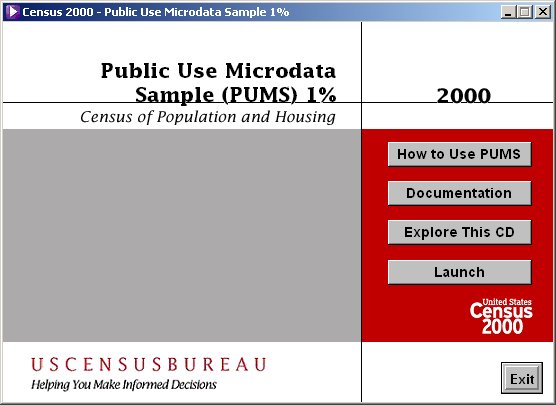
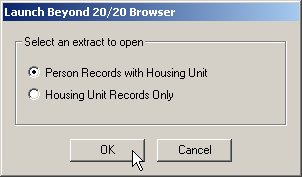
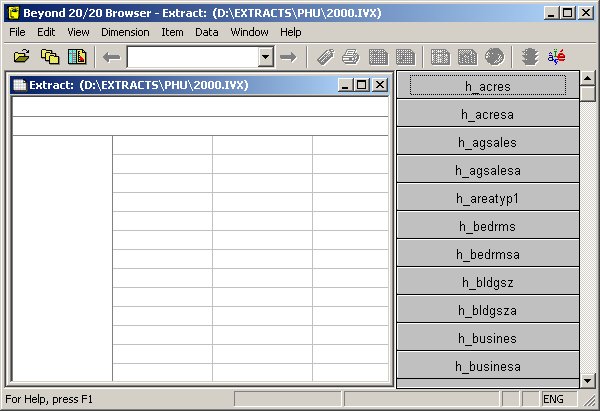
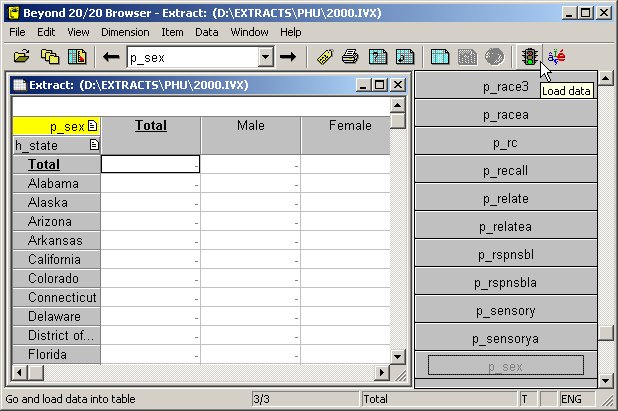
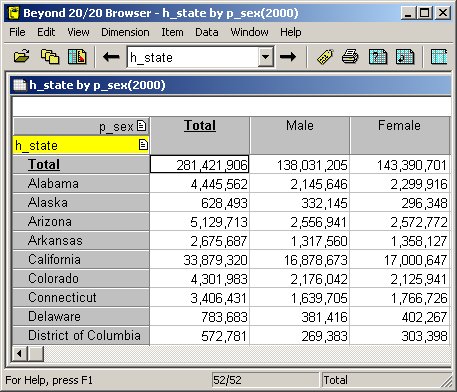
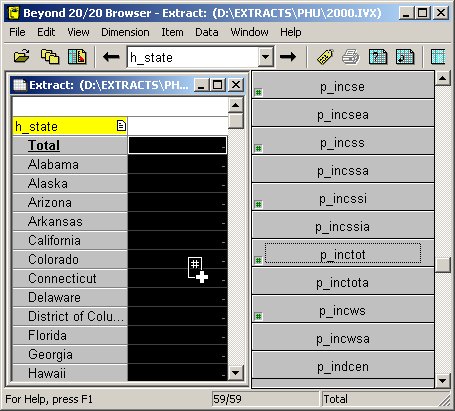
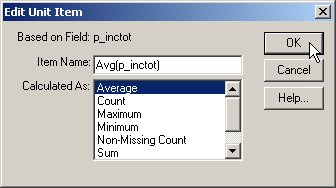
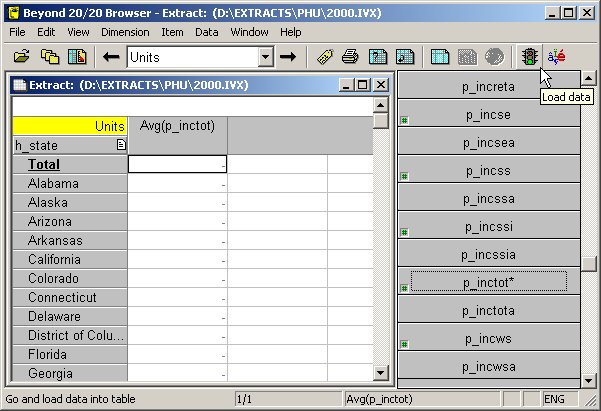
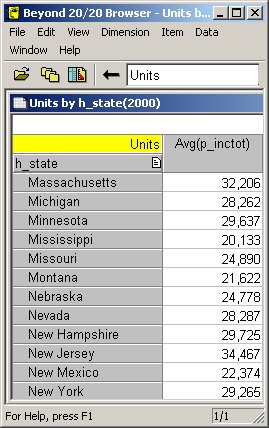
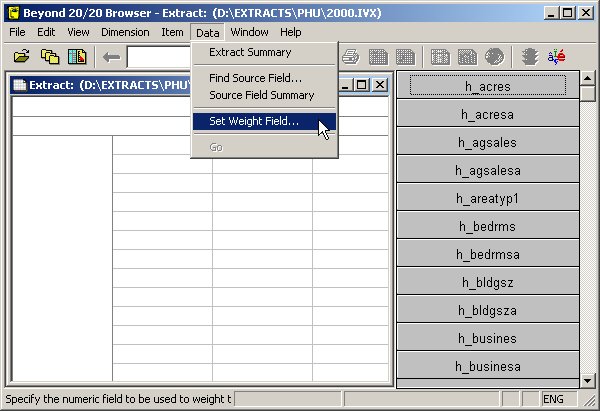
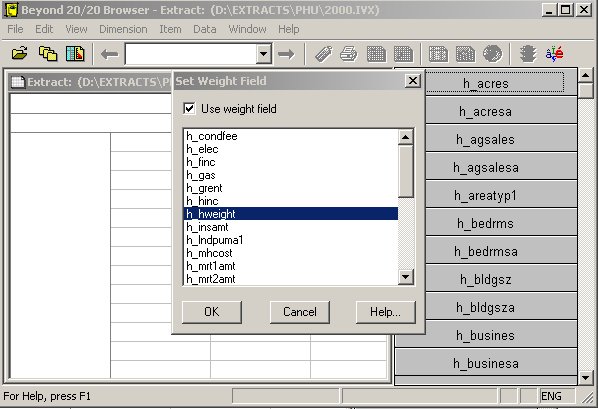
Recode variable
The list of categories for a variable can be changed by following the steps outlined below.
Right click on an existing variable and then select Define Recode as shown below. Next, click Yes to make a copy of the entire extract on another drive*.
The next step is to create new categories that include one or more pre-existing categories. Please note that the OK button is originally disabled. Each category from the original variable must be included in one of the new categories created for the recoded variable before the OK button is enabled. You may want to create a category named "Other" for the recoded variable that includes all of the remaining categories from the original variable that you are not interested in.
Click the "Add" button after highlighting one or more pre-existing categories and entering a name for the new category. If you click on the "Use As Is" button, no text label will be applied to the new category. Click on the OK button when all of the new categories have been created. The new recoded variable can now be used in place of the original variable.
A new variable in the example shown below has been created called p_pob_1 which has two categories (native-born and foreign-born) instead to the 325 categories in the original variable p_pob1.
* A copy of the extract or part of it must be made because the disc is a read-only medium. It is possible to copy a part of the extract by clicking on File, Save Extract As from the main menu and then selecting variables of interest plus one or both of the weight fields before getting started with the recode variable process.
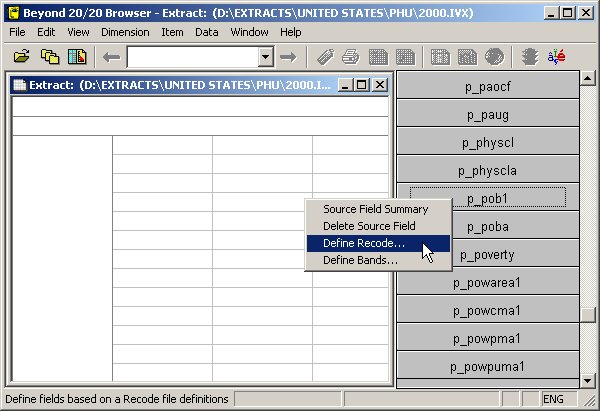
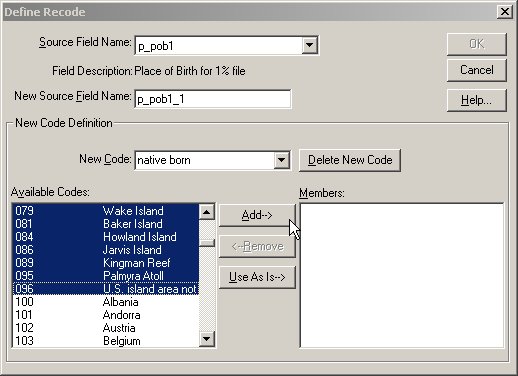
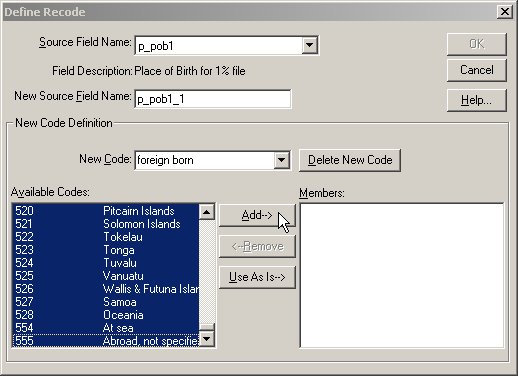
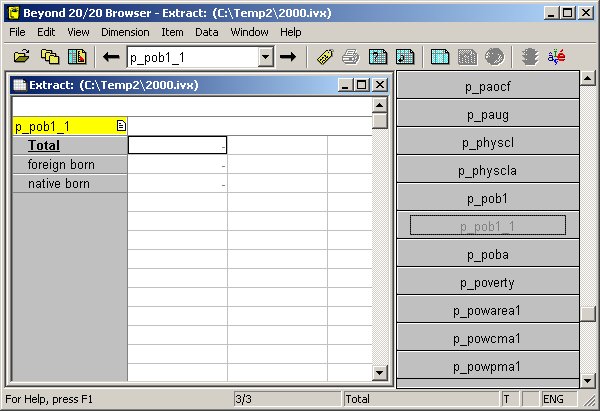
Software issues and updates
Income total variable category (note added on 10/03/2005)
The variable p_inctot includes a category incorrectly labeled $50,000 to $64,999. This category actually contains the number of people whose total income is $55,000 to $64,999. This can be seen by clicking on Dimension, then "Change Label" from the Beyond 20/20 browser menu twice.
Save Extract in SPSS format notes
This option can be extremely slow if you are exporting a large number of variables (dimensions) at one time. No record
selection criteria is available, so the number of records exported depends entirely upon the extract selected. You should be able to succesfully create SPSS output with about one or two dozen fields from any one of the PUMS 5% single state extracts or the PUMS 1% United States extracts relatively quickly. The actual runtime should be much less than an hour for most extracts if your PC is a relatively recent model. You may want to first try creating a small extract that includes just the variables you need for a specific cross tabulation plus any necessary weight field(s).
"Not enough memory to complete operation" message
The number of data items in a table is the product of the total number of categories for each dimension (variable).
Attempting to create a table with a large number of data items can result in a "Not enough memory to complete operation"
message. One option is to try creating the table on another PC with more RAM. A second option is to
recode one or more variables.
Technical Support
301-763-7710 Voice
301-457-1296 Fax
301-457-2347 Text-Telephone (TTY)
Last Revised: May 21, 2007 at 12:39:05 PM